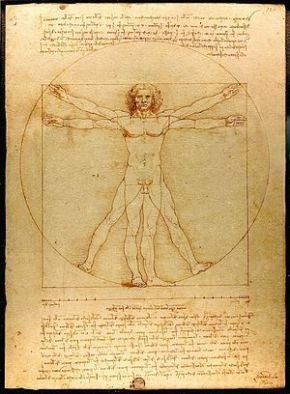The High Renaissance during sixteenth century Italy featured many talented artists, including da Vinci, Michelangelo and Raphael, who had their own methods to represent the ideas of the Renaissance. Leonardo da Vinci used many forms of art to convey his ideas, but his sketch of the Vitruvian Man, while it might not appeal as much as his other works, like the Mona Lisa, is still important.
The idea for the Vitruvian Man came from Vitruvius, an architect who researched the geometry and the proportions of the human body. Leonardo used the proportions discovered by Vitruvius in order to sketch out his subject. In the drawing, two poses of the human body are enclosed in a circle and a square. One pose has the arms stretched out and slightly angled up, with the legs spread apart. The second pose, directly on top of the other, features the body with the arms stretched straight out with the feet together and legs straight. The human body is completely nude, common of the Renaissance, and the notes on the top and bottom of the page are the details Leonardo copied from Vitruvius.

This work of art embodies the ideas of the Renaissance. Not only is the human body portrayed as a nude, it was drawn with exact measurements and proportions of the human body, for example, a palm is four fingers in length, and that the foot is one seventh the height of the man.These ideas demonstrate that the artists of the Renaissance began to see the human body as perfection, with every part of the body exactly where it should be located. The artists of the Renaissance began to center the human body in their artistic focus, and Leonardo da Vinci saw the human body as a perfectly natural, functioning machine. This lead him to connect and see the flawless proportions and perfection of the human throughout nature.
This is such a great example of how incredible da Vinci’s work is. Because you come from a science perspective, I really like that you chose this one, rather than something like a portrait. The Vitruvian Man, along with so many of da Vinci’s other sketches really demonstrate how art can be entirely related to more analytical, scientific-type thinking, especially when executed by a genius like da Vinci.
It’s nice to have such a seemingly enigmatic work as this one de-mystified. This is one of those images that we constantly exposed to, simply as a result of growing up in Western Society, and it’s comforting in a way to understand that it’s more than anything a study of the proportions of the ideal human body. Thanks for telling us about the palm-to-finger and foot-to-body length proportions, those are really cool and pretty impossible to figure out just by looking at the image.